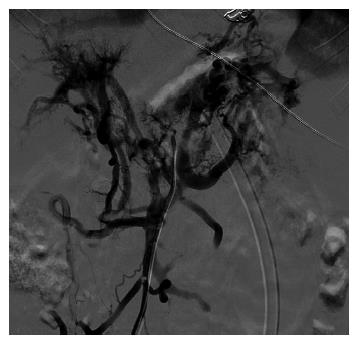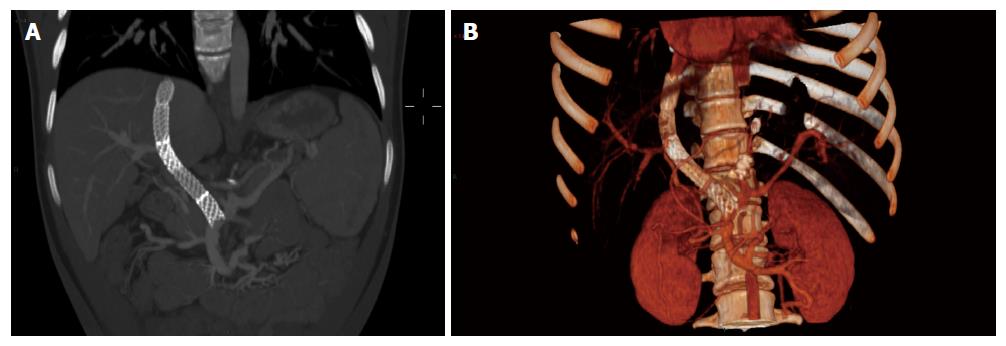Copyright
©The Author(s) 2017.
World J Gastroenterol. Apr 21, 2017; 23(15): 2811-2818
Published online Apr 21, 2017. doi: 10.3748/wjg.v23.i15.2811
Published online Apr 21, 2017. doi: 10.3748/wjg.v23.i15.2811
Figure 1 Axial computed tomography.
Portal cavernoma, enlarged spleen, and large varices.
Figure 2 Trans-mesenteric portal venography.
Showing patent superior mesenteric and splenic veins, large left gastric varicose veins; portal cavernoma and patent intrahepatic portal branches.
Figure 3 Minilaparotomy-assisted transmesenteric pre-dilation with 0.
018’ guide wire inserted 8 mm into the portal trunk after portal cavernoma recanalization with hydrophilic guide wire.
Figure 4 Venography with injection into the splenic vein after left gastric vein embolization and portal trunk pre-dilation.
No residual flow in varices. Guiding catheter parallel to the safety wire in the portal trunk.
Figure 5 Follow-up angiography.
Hepatopetal flow in the right portal branch. Hourglass shape of the under-dilated transjugular intrahepatic portosystemic shunt. Free fluid around the liver (before removal with suction and sponges).
Figure 6 Computed tomography MIP multiplanar coronal reconstruction at 1 mo follow up (A and B).
A: Residual waist of the TIPS stent, regular portal liver perfusion and preservation of splenic and superior mesenteric venous flow. No residual free fluid in the perihepatic space; B: Volume rendering 3D computed tomography reconstruction: varice exclusion and global perspective of the regular portal flow.
- Citation: Pelizzo G, Quaretti P, Moramarco LP, Corti R, Maestri M, Iacob G, Calcaterra V. One step minilaparotomy-assisted transmesenteric portal vein recanalization combined with transjugular intrahepatic portosystemic shunt placement: A novel surgical proposal in pediatrics. World J Gastroenterol 2017; 23(15): 2811-2818
- URL: https://www.wjgnet.com/1007-9327/full/v23/i15/2811.htm
- DOI: https://dx.doi.org/10.3748/wjg.v23.i15.2811














